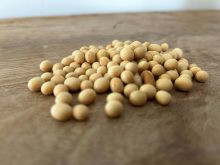Alberta packers were buying fed cattle in the range of $119-$121 per hundredweight (cwt) last week, which was the main factor causing feeders to trade steady to $2/cwt higher.
In Nebraska, slaughter steers traded at an all-time record high of $131/cwt as choice wholesale beef prices reached highs not seen since late 2003. The US. Department of Agriculture choice values touched an all-time high of $201.68/cwt while select prices were slightly lower last week at $190/cwt.
Middle meats are also trending higher, which is a sign of solid support of consumer demand moving into the full grilling season for the Victoria Day and Memorial Day holidays. Weather will continue to influence consumer behaviour moving forward, but inevitably summer conditions are right around the corner despite last week’s snowfall.
Read Also

U.S. grains: CBOT soybeans, corn, wheat fall in USDA data aftermath
Chicago grains took a dive on Friday, following a closely watched U.S. government crop report and the release of export data that could provide clues into Chinese buying.
Featured sales included a small group of mixed steers weighing just under 400 pounds at $175 in southern Alberta. Mixed exotic-based medium-flesh larger-frame steers averaging 700 lbs. traded at $146/cwt landed in southern Alberta. Simmental-cross backgrounded steers averaging just over 800 lbs. sold for $126/cwt in the same region. In central Alberta east of Edmonton, black Angus-cross steers weighing around 600 lbs. moved for $155/cwt. Heifers appeared to show sharper discounts this week but the market was quite variable depending on the region.
Statistics Canada reported barley stocks at three million tonnes as of March 31, which is down slightly from 3.3 million tonnes as of March 31, 2012. Feed usage appears to be running at a similar pace as last year while crop year-to-date exports are up 200,000 tonnes compared to the 2011-12 crop year. Cash barley readily traded at $293 per tonne delivered into southern Alberta feedlots and the market has been quite stable at these levels throughout the spring. Interesting to note that wheat used for feed was up almost one million tonnes compared to last year on the stocks report and this trend will continue for the remainder of the crop year.
Alberta feedlot margins are now entering positive territory for the first time this crop year. We should see the feeder market remain firm into the summer. The feedgrain market will remain strong until the seeding pace is over 50 per cent complete. Given the later seeding period, new-crop stocks will only be widely available in September, which could stem the upside in yearling cattle during August. Despite the current seeding conditions, I’m still expecting abundant feedgrain supplies next fall, which should bode well for upside in the feeder market next fall also.
— Jerry Klassen is a commodity market analyst in Winnipeg and maintains an interest in the family feedlot in southern Alberta. He writes an in-depth biweekly commentary, Canadian Feedlot and Cattle Market Analysis, for feedlot operators in Canada. He can be reached by email at [email protected] for questions or comments.
















